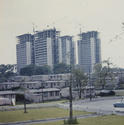 During this period handloom weaving continued and improved methods of agriculture were introduced, but most progress was made in the mining industry. Until 1799 miners were bound to a particular colliery for life, living in a state of virtual serfdom, but the employment of females and boys under ten died out in the Shettleston area before it was forbidden by law in 1842.
During this period handloom weaving continued and improved methods of agriculture were introduced, but most progress was made in the mining industry. Until 1799 miners were bound to a particular colliery for life, living in a state of virtual serfdom, but the employment of females and boys under ten died out in the Shettleston area before it was forbidden by law in 1842.
 James Gary installed the first steam engine in a mine in the Glasgow area at Carntyne in 1768. The improvements in drainage and the sinking of deeper mines coincided with the expansion of the iron industry in Monklands. The Clyde Iron Works were started at Fullarton in 1786 by Thomas Edington and William Cadell and taken over around 1812 by the Dunlop family, owners of the Tollcross estate.
James Gary installed the first steam engine in a mine in the Glasgow area at Carntyne in 1768. The improvements in drainage and the sinking of deeper mines coincided with the expansion of the iron industry in Monklands. The Clyde Iron Works were started at Fullarton in 1786 by Thomas Edington and William Cadell and taken over around 1812 by the Dunlop family, owners of the Tollcross estate.
 After the revolutionary invention of the hot-blast furnace at the works in 1828 by Shettleston-born James Neilson (1792-1865) the company became major producers of pig-iron. By 1840 some eighty families lived in the earliest of the Clyde Raws (Rows), workmen's houses built by the company which also provided a store and a school.
After the revolutionary invention of the hot-blast furnace at the works in 1828 by Shettleston-born James Neilson (1792-1865) the company became major producers of pig-iron. By 1840 some eighty families lived in the earliest of the Clyde Raws (Rows), workmen's houses built by the company which also provided a store and a school.
 To serve an increasing population, a new road, Main Street, was opened through Shettleston south of Old Shettleston Road. It continued eastwards past Shettleston Kirk and the Kirk House, a hostelry where horses and vehicles were put up during church service. A modern successor displays the date 1771. In the 1780s John MacMillan (1724-1808), a minister of the Reformed Presbyterian Church, held open-air communions in summer on the Preaching Braes at Sandyhills.
To serve an increasing population, a new road, Main Street, was opened through Shettleston south of Old Shettleston Road. It continued eastwards past Shettleston Kirk and the Kirk House, a hostelry where horses and vehicles were put up during church service. A modern successor displays the date 1771. In the 1780s John MacMillan (1724-1808), a minister of the Reformed Presbyterian Church, held open-air communions in summer on the Preaching Braes at Sandyhills.